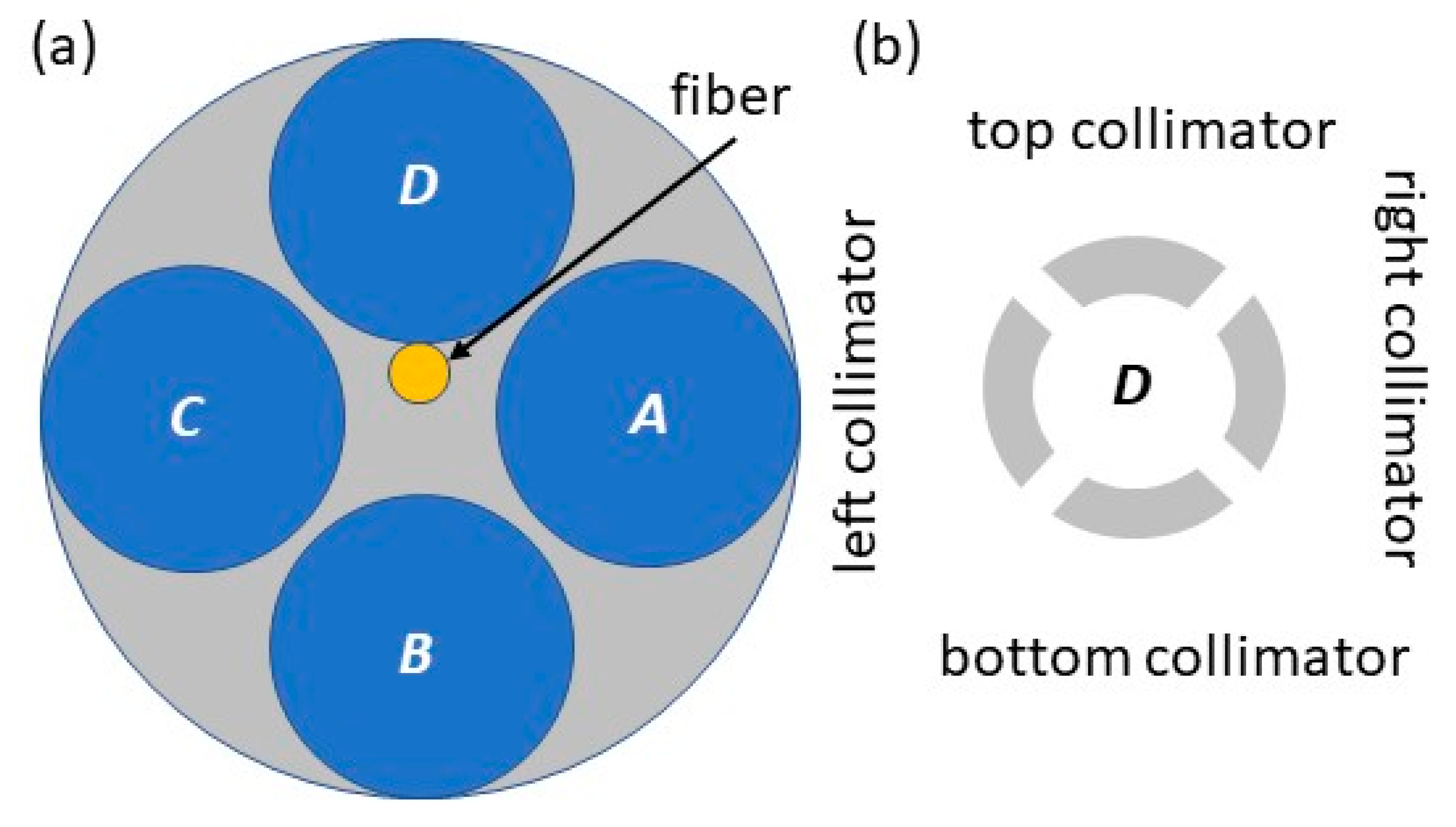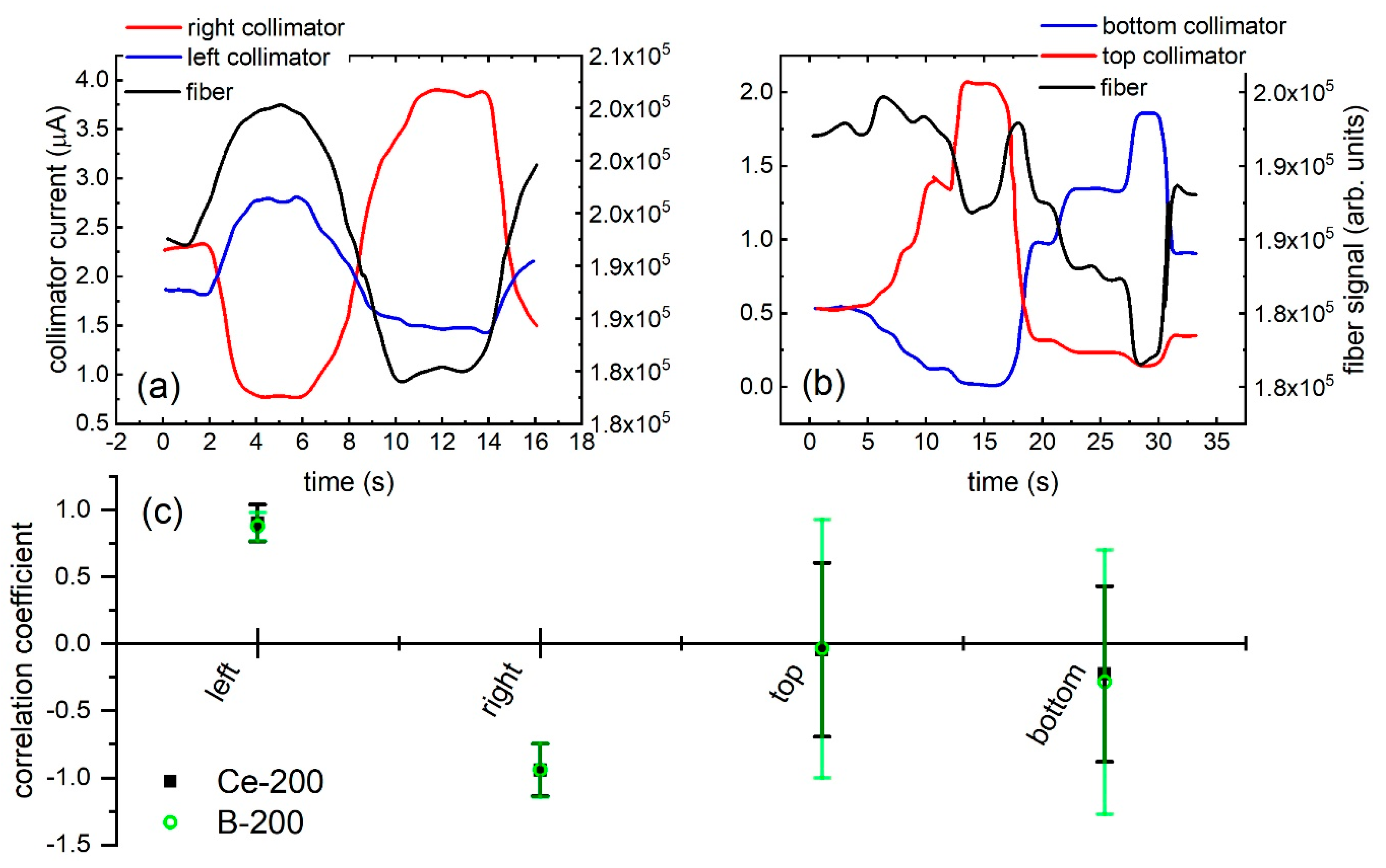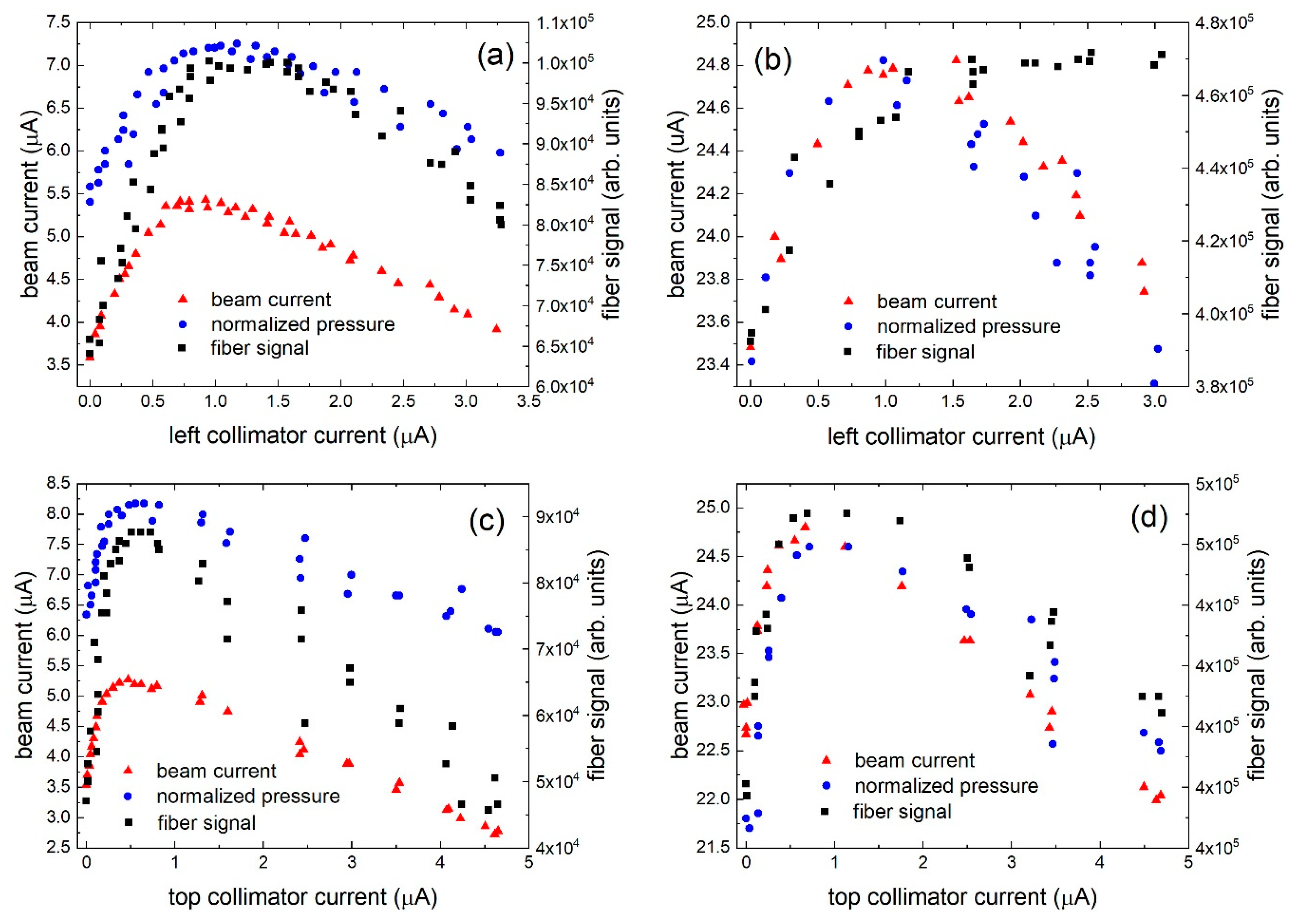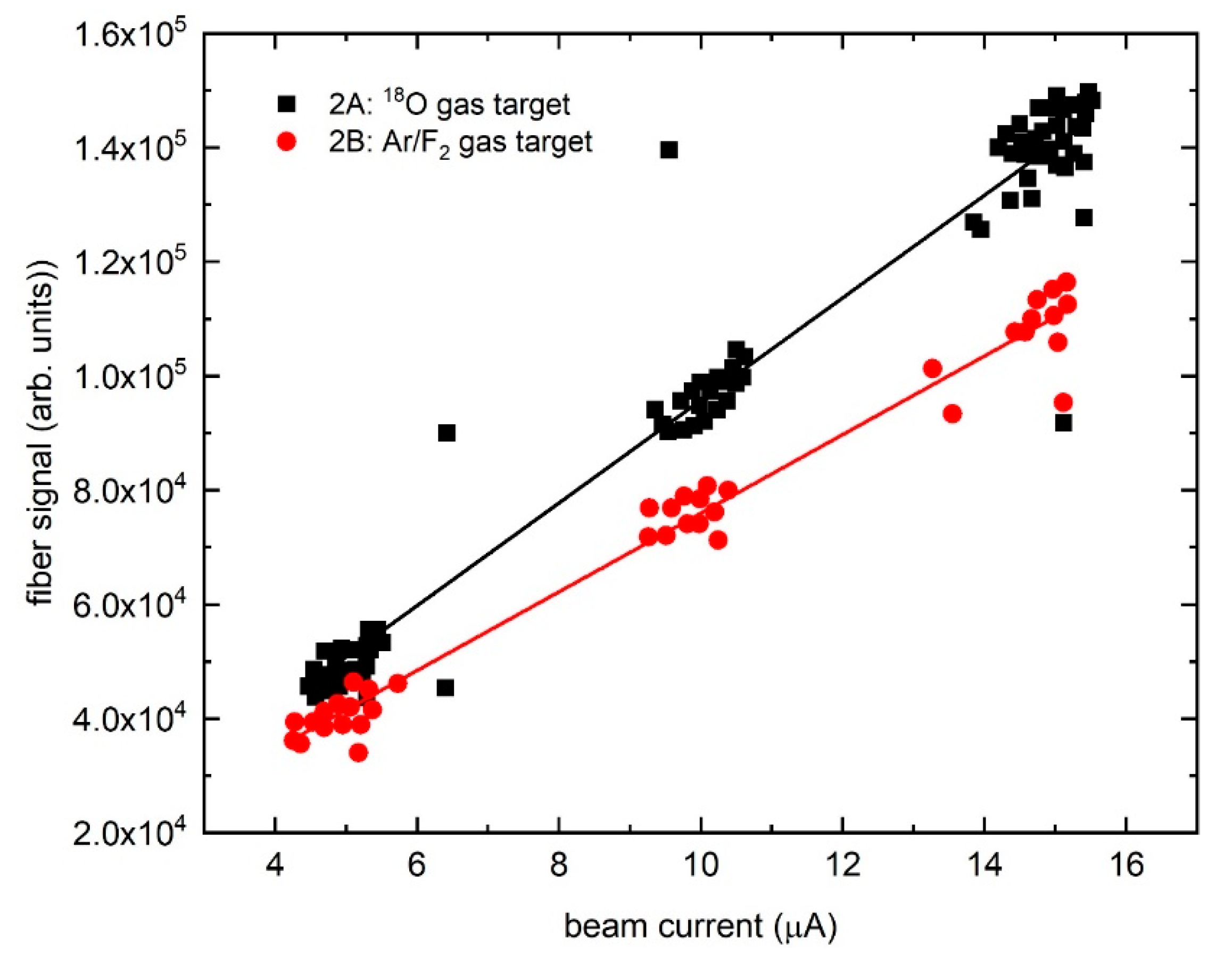Ce- and B-Doped Silica Fibers for Monitoring Low-Energy Proton Beams on a Medical Cyclotron
Abstract
Featured Application
Abstract
1. Introduction
2. Materials and Methods
2.1. Fiber Optic Setup
2.2. TR13 Cyclotron
2.3. Analysis
3. Results and Discussion
3.1. Beam-Current Effect
3.2. Beam-Alignment Effect
3.3. Target-Material Effect
4. Conclusions
Author Contributions
Funding
Acknowledgments
Conflicts of Interest
References
- Hendriks, C.; Uittenbosch, T.; Cameron, D.; Kellogg, S.; Gray, D.; Buckley, K.; Schaffer, P.; Verzilov, V.; Hoehr, C. A real-time intercepting beam-profile monitor for a medical cyclotron. Rev. Sci. Instrum. 2013, 84, 113305. [Google Scholar] [CrossRef] [PubMed]
- Gelbart, W.; Johnson, R.; Abeysekera, B. Simple beam profile monitor. AIP Conf. Proc. 2012, 1509, 38–40. [Google Scholar]
- Avila-Rodriguez, M.; Wilson, J.; McQuarrie, S. The use of radiochromic films to measure and analyze the beam profile of charged particle accelerators. Appl. Radiat. Isot. 2009, 67, 2025–2028. [Google Scholar] [CrossRef] [PubMed]
- Laxdal, R.; Altman, A.; Kuo, T.; Kadantsev, T. Beam measurements on a small commercial cyclotron. In Proceedings of the Europen Particle Accelerator Conference, London, UK, 27 June–1 July 1994. TRI-PP-94-56. [Google Scholar]
- Avila-Rodriguez, M.; Wilson, J.; McQuarrie, S. A Simple Method for Measuring the Beam Profile of Charged Particle Accelerators. In Proceedings of the 12th International Workshop on Targetry and Target Chemistry, Seattle, WA, USA, 21–24 July 2008; Available online: https://wttc.triumf.ca/pdf/2008/WTTC12ABSTRACTBOOK.pdf (accessed on 11 April 2019).
- Vedda, A.; Chiodini, N.; Di Martino, D.; Fasoli, M.; Keffer, S.; Lauria, A.; Martini, M.; Moretti, F.; Spinolo, G.; Nikl, M.; et al. Ce3+-doped fibers for remote radiation dosimetry. Appl. Phys. Lett. 2004, 85, 6356–6358. [Google Scholar] [CrossRef]
- Mones, E.; Veronese, I.; Moretti, F.; Fasoli, M.; Loi, G.; Negri, E.; Brambilla, M.; Chiodini, N.; Brambilla, G.; Vedda, A. Feasibility study for the use of Ce3+-doped optical fibres in radiotherapy. Nucl. Instrum. Methods Phys. Res. Sect. A 2006, 562, 449–455. [Google Scholar] [CrossRef]
- Veronese, I.; Cantone, M.; Chiodini, N.; Coray, A.; Fasoli, M.; Lomax, A.; Mones, E.; Moretti, F.; Vedda, A. Feasibility study for the use of cerium-doped silica fibres in proton therapy. Radiat. Meas. 2010, 45, 635–639. [Google Scholar] [CrossRef]
- Girard, S.; Di Francesca, D.; Morana, A.; Hoehr, C.; Paillet, P.; Duzenli, C.; Kerboub, N.; Reghioua, I.; Li Vecchi, G.; Alessi, A.; et al. X-Rays, γ-Rays, and Proton Beam Monitoring With Multimode Nitrogen-Doped Optical Fiber. IEEE Trans. Nucl. Sci. 2019, 66, 306–311. [Google Scholar] [CrossRef]
- Savard, N.; Potkins, D.; Beaudry, J.; Jirasek, A.; Duzenli, C.; Hoehr, C. Characteristics of a Ce-Doped silica fiber irradiated by 74 MeV protons. Radiat. Meas. 2018, 114, 19–24. [Google Scholar] [CrossRef]
- Nesteruk, K.; Auger, M.; Braccini, S.; Carzaniga, T.; Ereditato, A.; Scampoli, P. A system for online beam emittance measurements and proton beam characterization. J. Instrum. 2018, 13, P01011. [Google Scholar] [CrossRef]
- Yanagida, Y. Study of rare-earth-doped scintillators. Opt. Mater. 2013, 35, 1987–1992. [Google Scholar] [CrossRef]
- Girard, S.; Capoen, B.; El Hamzaoui, H.; Bouazaoui, M.; Bouwmans, G.; Morana, A.; Di Francesca, D.; Boukenter, A.; Duhamel, O.; Paillet, P.; et al. Potential of Copper- and Cerium-doped Optical Fiber Materials for Proton Beam Dosimetry. IEEE Trans. Nuclear Sci. 2017, 64, 567. [Google Scholar] [CrossRef]
- Barnhart, T.E.; Engle, J.W.; Valdovinos, H.F.; Severin, G.W.; Nickles, R.J. Prompt radiation detectors to monitor target conditions. AIP Conf. Proc. 2012, 1509, 34–37. [Google Scholar]
- Buckley, K.R.; Huser, J.; Jivan, S.; Chun, S.K.; Ruth, T.J. 11C-methane production in small volume, high pressure gas targets. Radiochim. Acta 2000, 88, 201–205. [Google Scholar] [CrossRef]
- Braccini, S.; Ereditato, A.; Giacoppo, F.; Kreslo, I.; Nesteruk, K.; Nirkko, M.; Weber, M.; Scampoli, P.; Neff, M.; Pilz, S.; et al. A beam monitor detector based on doped silica and optical fibres. J. Instrum. 2012, 7, T02001. [Google Scholar] [CrossRef][Green Version]








| Fiber | Dopant | Length | Diameter |
|---|---|---|---|
| Ce-600 | Ce3+ | 8.0 cm | 600 µm |
| Ce-200 | Ce3+ | 3.0 cm | 200 µm |
| B-200 | B3+ | 7.5 cm | 200 µm |
| Run | Target Material | Target Position | Fiber Position on Target D | Fiber(s) Used | Conditions |
|---|---|---|---|---|---|
| 1A | Solid Tl | B | Inner | Ce-600 | Up to 10 µA, no beam steering |
| 1B | Water | A | Inner | Ce-600 | Up to 20 µA, no beam steering |
| 1C | 18O gas | D | Inner | Ce-600 | Up to 25 µA, no beam steering |
| 1D | 18O gas | D | Inner | Ce-200 & B-200 | Up to 25 µA, no beam steering |
| 2A | 18O gas | D | All four target quadrants | Ce-200 & B-200 | Up to 25 µA, regular steering |
| 2B | Ar/F2 | D | All four target quadrants | Ce-200 & B-200 | Up to 15 µAs, regular steering |
| 3 | 18O gas | D | Inner | Ce-200 & B-200 | Up to 25 µAs, intense steering |
© 2020 by the authors. Licensee MDPI, Basel, Switzerland. This article is an open access article distributed under the terms and conditions of the Creative Commons Attribution (CC BY) license (http://creativecommons.org/licenses/by/4.0/).
Share and Cite
Hoehr, C.; Hanna, M.; Zeisler, S.; Penner, C.; Stokely, M.; Dehnel, M. Ce- and B-Doped Silica Fibers for Monitoring Low-Energy Proton Beams on a Medical Cyclotron. Appl. Sci. 2020, 10, 4488. https://doi.org/10.3390/app10134488
Hoehr C, Hanna M, Zeisler S, Penner C, Stokely M, Dehnel M. Ce- and B-Doped Silica Fibers for Monitoring Low-Energy Proton Beams on a Medical Cyclotron. Applied Sciences. 2020; 10(13):4488. https://doi.org/10.3390/app10134488
Chicago/Turabian StyleHoehr, Cornelia, Matthew Hanna, Stefan Zeisler, Crystal Penner, Matthew Stokely, and Morgan Dehnel. 2020. "Ce- and B-Doped Silica Fibers for Monitoring Low-Energy Proton Beams on a Medical Cyclotron" Applied Sciences 10, no. 13: 4488. https://doi.org/10.3390/app10134488
APA StyleHoehr, C., Hanna, M., Zeisler, S., Penner, C., Stokely, M., & Dehnel, M. (2020). Ce- and B-Doped Silica Fibers for Monitoring Low-Energy Proton Beams on a Medical Cyclotron. Applied Sciences, 10(13), 4488. https://doi.org/10.3390/app10134488




